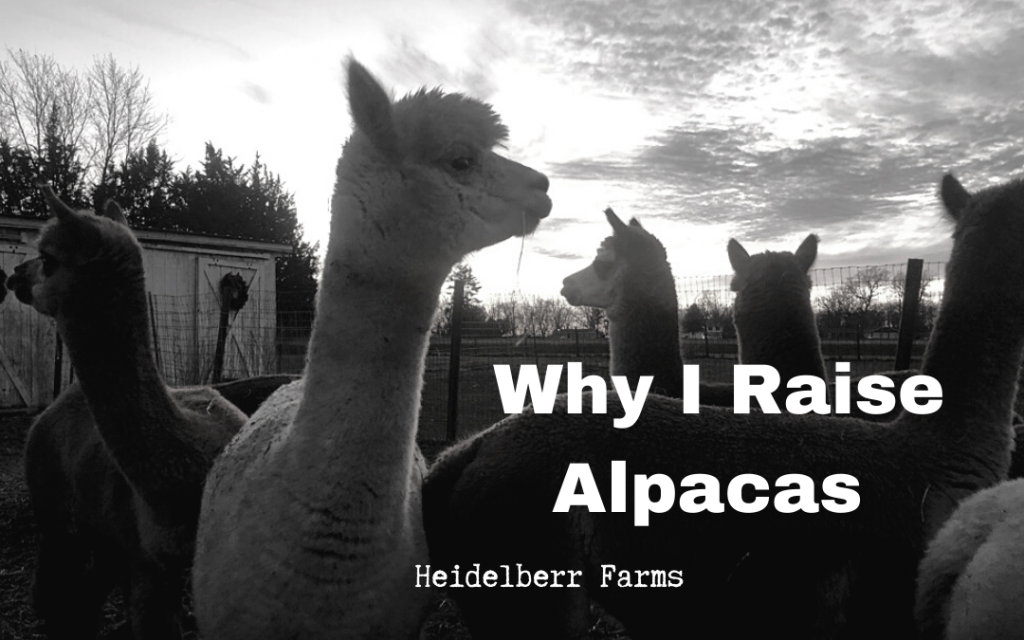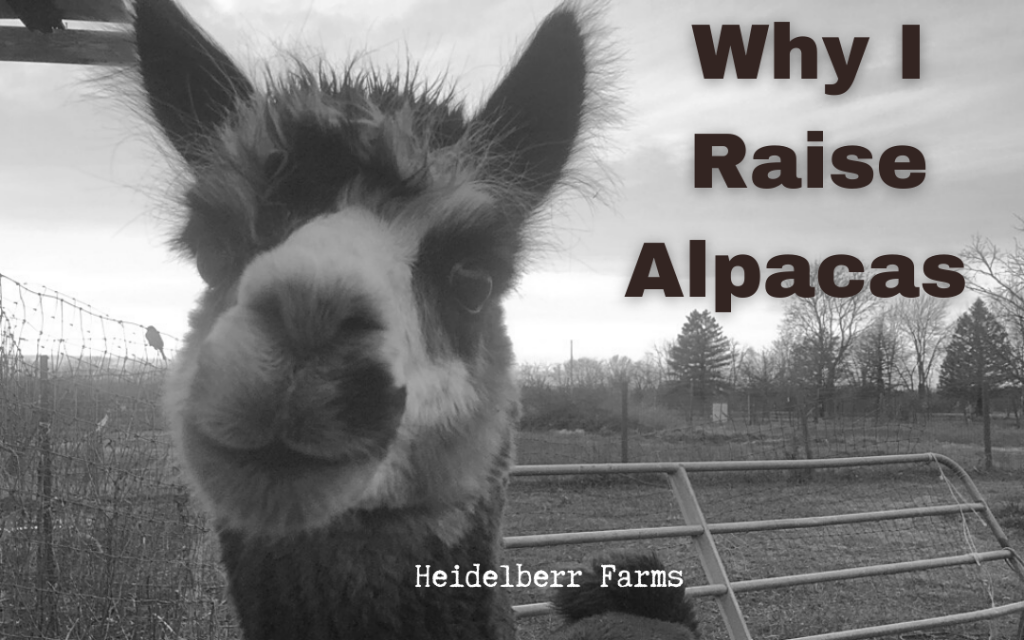
Why I Raise Alpacas
When I first started writing this post, it was still -10 degrees outside. So naturally, this is the perfect motivation for asking myself why on earth DO I raise alpacas?
Why on earth am I putting myself through this?!
This is as much of a reminder to myself as it is education for you, my friend!
If you ask 100 alpaca farmers why they got into alpacas, I guarantee that you will get 120 different responses and each of them will be completely valid.
When striving for a goal, it is important–whether you are considering bringing alpacas onto your farm or you are looking to go back to school–to follow Simon Sinek’s advice and “know your why”.
Know Your Why
My why goes all the way back to childhood. Simply put, I was always going to raise something. There was never any doubt about that. If you would have asked 5 year old Leslie what that something would have been she would have said “horsies”. And guess what? Forty-something year old Leslie still wants horsies. Really bad.
But forty-something Leslie has just a little more wisdom and restraint than five year old Leslie. And forty-something Leslie has also learned to research.
The Importance of Research
Now that we’ve brought up the subject of research, let’s take a closer look at what drew me to alpacas. In short, I had a list of needs and wants and I was looking for an animal to bring to my farm that would be a good fit for experience level and my property.
I can’t stress the importance of this. You must research your prospective animal partner. It is unfair to expect an animal to mold to your situation. Some are quite adept, and that’s great. But more often than not, it’s a recipe for heartache.
For example, if you’re looking for a canine partner to take on a long run, do not get a heavy-boned, short-faced, bulldog and expect it to be able to keep up. It’s not fair to the dog and, frankly, you’ll get really tired carrying it for 4.5 out of 5 miles. Unless running with a 40 pound weight is your thing, then by all means go for it and enjoy every mile!
Many of these animals have been bred for thousands of years to fulfil a niche. That genetic history is already there and it is a very powerful tool. A good fit not only makes the farmer’s life easier, but your animals’ lives more stress-free. Just as it is not fair to expect a dog selectively bred to strictly be a lap companion to fulfill a role that they are not physically or mentally equipped for, it is also not fair to throw a livestock species into a situation in where it cannot thrive. They don’t get to choose where they live, so you must choose wisely for them. I could rant further, but that will have to be a separate blog post.
Let me explain this a little better. If you decided that you want to raise sheep. Well, there are scores of sheep breeds. All bred for specific purposes, functions, or even to thrive in a particular climate. If you live in an a very humid environment, you might want to look for sheep breeds that thrive in such an environment. It’s your choice, certainly, but working with nature rather than against it just tends to cost less time and effort in the long run. Anything else is an uphill battle.
So back to not expecting an animal to fulfill a physical, geographical, or emotional need that they are not suited to fulfil…
I wanted to make sure that any animal that I brought on to my farm, would fit the farm in order to be fair to the animal. And I’m not going to lie, I also love efficiency like nobody’s business. So if I had to expend 10x the effort to make something work, that’s a pretty big red flag that it’s just not worth the effort. Knowing myself and what I was willing to do, or not do, I came up with a list of non-negotiables.
My List of Needs
- Easy on the land (doesn’t tear up pasture)
- Can thrive on smaller acreage (I only have 7)
- Low maintenance
- Economical to feed
- Can safely keep breeding males without the fear of maiming, injury, or death*. No, really.
- In addition to breeding male safety, I also want them to not be disgusting (sorry, goats).
- Can produce a sustainable product that generates profit
- Can be taken care of safely by my 70 year old mother in my absence.
- A generally healthy animal that does not need chemical intervention in order to survive.
When I look at each of these items, the alpaca checks off each and every requirement compared to most other livestock species.
This in no way denigrates the other livestock species. Remember, this is about my specific situation at a specific point in time 15 years ago. Yours will be different and that’s a beautiful thing.
For that matter, my list would also be different if I were to start all over again. Alas, that is also another blog post!
Okay, perfect. Alpacas appear to be awesome on the surface and they appear to meet MY needs. But the next thing that I had to research was if I could meet THEIRS.
Here is what the alpacas need from me
- Adequate shelter from the elements –
- Whether or not they choose to use it, they have to have the option. A simple 3-sided shelter is perfectly adequate. You do not need a fancy barn.
- Alpacas must have alpaca buddies. A herd of three alpacas is the minimum with very few exceptions. So few that we won’t even bother to list them. Do not get a single alpaca and expect it to live happily.
- Fresh water available at all times
- Suitable hay according to their age, sex, breeding/nursing status.
- A soft grass hay is good for most herds, most of the time
- Nursing mothers benefit from alfalfa
- Don’t feed alfalfa to males
- Don’t be surprised if you need to carry more than one hay type to suit all the above
- Proper fencing with the goal to keep predators OUT and not so much the alpacas IN
- Males housed separately from females
- I don’t care if they’re gelded. They still don’t belong with females.
- Their fleece MUST be sheared once a year before it gets too hot
- A loose mineral mix available free choice year round
- Be prepared to put a coat on a young, old, or skinny animal in extreme cold. If it shivers, it needs a cover. If it is not shivering, leave it alone.
Is this an all-inclusive list? Absolutely not. But this will get you a foundation of knowledge on which to build your research. After all, I’m depending on you to research-research-research.

My goal is to do one of two things
- Help you realize that alpacas are a lovely and viable addition to a small farm operation.
- Help you realize that alpacas are not a fit for you. At least not now.
There is no shame to either of these options. If number two applies to you, then I am proud of you for realizing this early on.
Some additional considerations
- Alpacas are incredibly cute and yet they are still livestock.
- They still need to be cared for 1-2x per day
- Even in blizzards
- Especially in blizzards
- They make horrible pets***
I am now about ready to wrap up this overly wordy post. In the time that it’s taken to write this, it has finally warmed up to a balmy zero degrees. It only took eight hours to get there.
I’ve made no less than eight trips outside to break water for the chickens and to collect eggs before they freeze. I pulled a sled full of hay to the boys. And, I have once again affirmed to myself that alpacas are pretty awesome and totally worth the effort whether it is -20 or 120 degrees outside.
I’ll be perfectly honest in telling you that my ultra warm alpaca hat and socks do a great deal to convince me of the amazingness of alpacas – even when, especially when, I’m taking care of them in subzero weather.
Now, I just need to convince myself about the chickens.
Oh, I’m just kidding.
Mostly.
But, I’m also a little bit serious.
Then again, the eggs ARE amazing.
Alright, shut up Leslie.
After a long spell (THREE YEARS, LESLIE) of not having a clue of what to write, this one single post has generated a lot of need for follow up. I guess I’m going to be busy this year!
Talk to you again soon!
*I never fully trust my males. This is my personal rule when dealing with all forms of livestock. At the end of the day, my safety is still my responsibility. Sorry boys, I love you all, but you are still ruled by your hormones and I never know when they’re going to kick in. And because I never know when they’re going to kick in, I am always prepared for it at the least opportune moment.
***This topic really requires a full post fully explaining what I define as a “pet”. Let me summarize this quickly: Alpacas make horrible pets as-in “look at my alpaca who lives all alone in my backyard and I am doing my level best to turn it into a dog, isn’t it great?!”
Contrast this with: alpacas make decent pets as-in “look at my five alpacas who I keep according to good livestock management practices and who I like to spend time watching in my pastures, but I’m not forcing them to do anything against their nature. I also don’t expect anything from them economically except for my own pleasure from watching them. Aren’t they great?!” If this is your idea of a “pet” situation, then I agree – alpacas make great pets!


Recent Comments